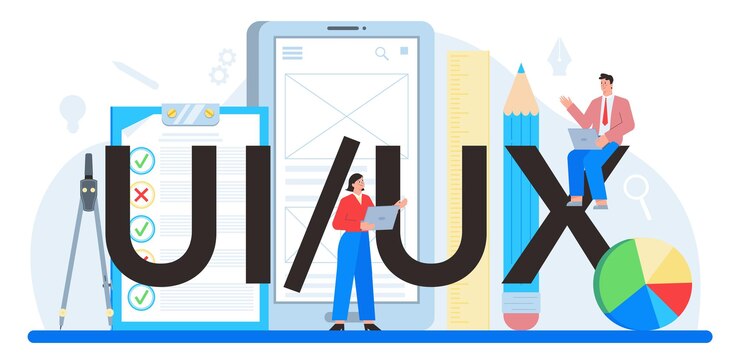In custom software development, UX/UI design plays a critical role in ensuring the application is not only functional but also user-friendly and achieves its intended goals. Here’s a breakdown of their contributions:
Understanding the Difference:
- UX (User Experience) Design: Focuses on the big picture – the entire journey a user takes while interacting with the software. It considers user needs, goals, behaviors, and pain points to design a smooth and satisfying experience. This involves research through interviews, surveys, and user testing.
- UI (User Interface) Design: Deals with the software’s visual appearance and interactive elements. It includes designing screens, buttons, menus, icons, and other components that users see and interact with. Essentially, it’s the look and feel of the application.
Why They Matter Together:
- Interdependence: A well-designed UX needs a clear and intuitive UI to function effectively. For instance, a well-defined user flow (UX) might be hampered by a confusing layout (UI)
- Unified Goal: Both UX and UI work towards creating a seamless user experience. UX design ensures users can achieve their tasks effortlessly, while UI design makes the interaction clear and enjoyable.
- Design Flow: UX design typically comes first, establishing the foundation for the UI. However, they are iterative processes, meaning they inform and influence each other throughout development.
Benefits of Strong UX/UI in Custom Software:
- Increased User Adoption: Easy-to-use software with a clear purpose is more likely to be adopted and used regularly by the target audience.
- Improved User Satisfaction: A positive user experience leads to higher satisfaction and can foster brand loyalty.
- Enhanced Efficiency: An intuitive design allows users to complete tasks quickly and minimizes errors.
- Reduced Development Costs: Early identification of usability issues through UX research can prevent costly rework later in development.
- Competitive Advantage: In a crowded software market, a user-centric design can differentiate your custom software from the competition.
By investing in UX/UI design, custom software development can create applications that are not only functional but also meet the specific needs of their users and contribute to the overall success of the project.
The Role of UX/UI Design in Custom Software Development: Why is ui/ux Design Important
UI/UX design is crucial for several reasons:
- Creates Positive First Impressions: In today’s digital world, first impressions matter. A well-designed UI with a smooth UX can grab users’ attention and make them more likely to engage with your product or website.
- Boosts Usability and Efficiency: A well-designed interface is intuitive and easy to use. Users can find what they need quickly and complete tasks efficiently, leading to a more satisfying experience.
- Increases User Satisfaction and Retention: If users find your product or website frustrating or difficult to navigate, they’re more likely to abandon it. Conversely, a positive UX keeps users engaged and happy, fostering loyalty and encouraging them to return.
- Improves Conversion Rates: Whether it’s making a purchase, signing up for a service, or completing a form, a seamless UX streamlines the process and increases the chances of users converting.
- Enhances Brand Image: A well-designed UI can communicate your brand’s personality and values. It can also build trust and credibility with users, making them more likely to view your brand favorably.
- Provides a Competitive Advantage: In a crowded marketplace, a user-centric design can differentiate your product or website from the competition. Strong UI/UX design can give you a significant edge.
- Reduces Development Costs: Investing in UX/UI design upfront can help identify usability issues early on. This prevents costly rework later in the development process.
- Boosts SEO (Search Engine Optimization): Search engines consider user experience when ranking websites. A well-designed website with a positive UX tends to rank higher in search results, leading to increased organic traffic.
Overall, UI/UX design plays a vital role in creating successful digital products and websites. By focusing on user needs and creating a positive user experience, you can achieve your business goals and gain a competitive edge.
Purpose of ui ux Design

The ultimate purpose of UI/UX design is to create a positive and engaging user experience. This means designing interfaces (UI) that are attractive, easy to understand, and enjoyable to use, while also crafting the overall user journey (UX) to be efficient, intuitive, and meet the user’s specific goals.
Here’s a breakdown of the two sides of the coin:
- UI (User Interface) Design: Focuses on the look and feel of the product, including the visual elements and interactive components. It’s essentially the user’s visual conversation with the product. A well-designed UI should be clear, functional, and aesthetically pleasing.
- UX (User Experience) Design: Concerned with the user’s entire journey when interacting with the product. It considers the user’s needs, motivations, and pain points to design a smooth and satisfying experience. This involves user research to understand user behavior and inform the design process.
Think of UI/UX design like designing a restaurant. The UI is the decor, furniture, and menu layout – it should be inviting and easy to understand. The UX is the entire dining experience – from being greeted to placing your order, getting your food, and paying the bill – it should be efficient and enjoyable.
In essence, UI/UX design aims to bridge the gap between a product’s functionality and how users interact with it. By creating a user-centered design, you can ensure your product is not only functional but also achieves its intended goals and leaves a lasting positive impression on users.
The Role of UX/UI Design in Custom Software Development: Advantages’ & Disadvantages ui ux design
Advantages of UI/UX Design
UI/UX design offers a wide range of benefits for businesses and users alike. Here are some of the key advantages:
- Enhanced User Experience (UX): This is the core benefit. A well-designed UX makes interacting with a product or website smooth, intuitive, and enjoyable. Users can find information and complete tasks efficiently, leading to higher satisfaction.
- Increased User Adoption & Retention: Easy-to-use interfaces with clear value propositions are more likely to be adopted by users and used regularly. This can lead to higher customer retention and brand loyalty.
- Improved Conversion Rates: A seamless UX streamlines processes like making purchases or signing up for services, which can significantly boost conversion rates.
- Reduced Development Costs: Early identification of usability issues through UX research can prevent costly rework later in development.
- Competitive Advantage: In a crowded market, a user-centric design can differentiate your product from the competition and give you a significant edge.
- Boosted Brand Image: A well-designed UI can effectively communicate your brand’s personality and values, fostering trust and a positive brand perception.
- Increased Efficiency: An intuitive design allows users to complete tasks quickly and minimizes errors, leading to overall operational efficiency.
- Improved SEO: Search engines consider user experience when ranking websites. A well-designed website with a positive UX tends to rank higher in search results, leading to increased organic traffic.
Disadvantages of UI/UX Design
While the advantages are significant, there are also some potential drawbacks to consider:
- Upfront Investment: Investing in UX/UI design requires time and resources. This can be a barrier for smaller businesses or those with tight budgets.
- Iterative Process: UX/UI design is an iterative process, meaning there’s a constant loop of research, design, testing, and refinement. This can be time-consuming and require flexibility.
- Subjectivity: What constitutes a “good” UI/UX can be subjective and depend on user preferences and cultural contexts. What works for one audience might not work for another.
- Finding the Right Talent: Hiring skilled UX/UI designers can be challenging, especially for businesses with limited resources or experience in this field.
- Scope Creep: The design process can sometimes lead to scope creep, where additional features or functionalities are added beyond the initial project scope. This can impact timelines and budgets.
However, by carefully planning the design process, understanding target users, and setting clear expectations, these potential drawbacks can be mitigated. Overall, the advantages of UI/UX design far outweigh the disadvantages for most businesses.



